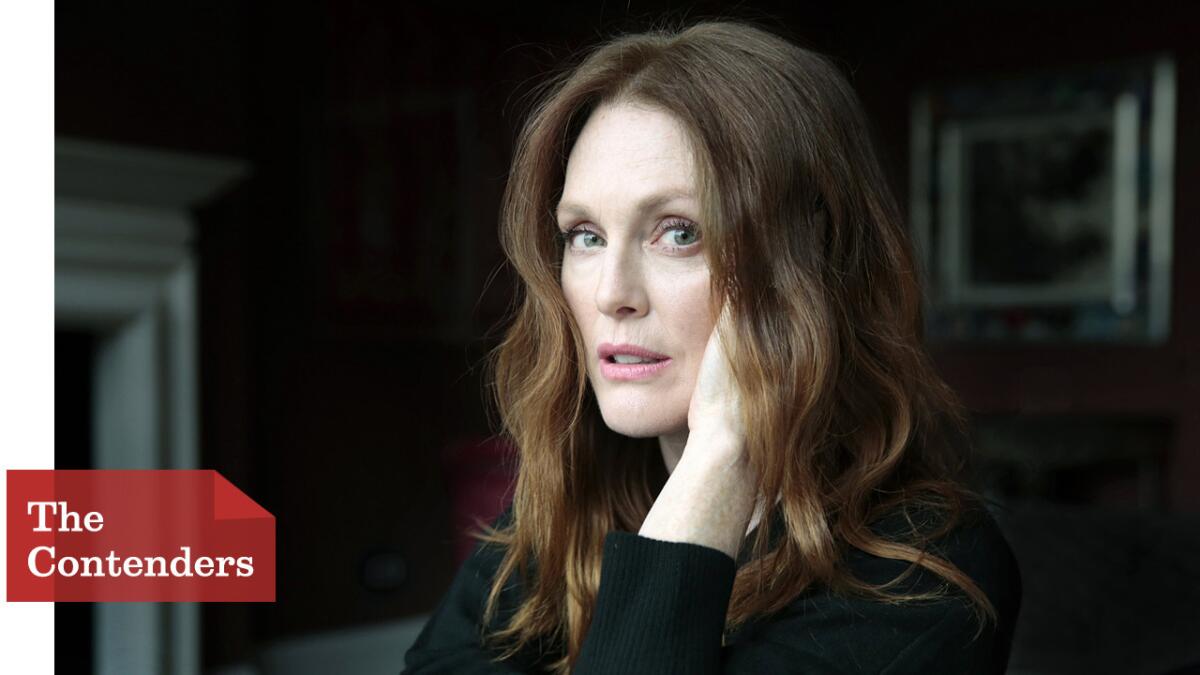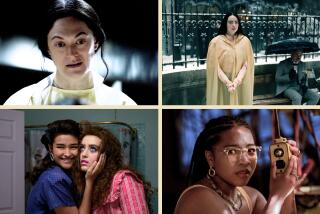Julianne Moore brings affecting realism to ‘Still Alice’ role

Early in “Still Alice,” Julianne Moore — as wife, mother and professor Alice Howland — faces a series of cognitive tests administered by her neurologist. She’s begun forgetting things ranging from simple words to her location, and mistakenly self-diagnoses a brain tumor. But the scene isn’t about those tests or about her dawning realization that, rather than a tumor, she may have early-onset Alzheimer’s. It’s about Moore’s visage.
The shot remains on her for four solid minutes, an eternity in moviemaking but an easy choice for director Wash Westmoreland (who also wrote the screenplay with partner Richard Glatzer).
FULL COVERAGE: Oscars 2015
“Julianne Moore is the queen of realism,” he says in a phone interview. “She was determined not to do a false note in the performance. We didn’t want to slip into medical drama, which we’ve seen many times. Instead, it’s all about what happened in her face.”
Moore had no idea Westmoreland and Glatzer would choose that single, unbroken take. “When I saw the cut of me in the doctor’s office, I was like, ‘Are you kidding me?’ It was like a present,” she says as she glances out the bar window of the Gansevoort Meatpacking NYC hotel,sipping her tea and nibbling the peel of a lemon.
“Still Alice” is the story of a woman in her prime whose expertise in linguistics has propelled her into a professorship at Columbia University — but who is then diagnosed with the degenerative brain disorder. It could have been mere movie-of-the-week pulp in lesser hands, but Westmoreland and Glatzer put Moore’s chiseled, ivory features and clever, knowing eyes front-and-center and never looked back. No wonder she’s been earning critical raves and industry awards since the drama premiered in September at the Toronto International Film Festival.
And with five Academy Award nominations to date, starting in 1998, there’s a good chance this role will be the one to earn Moore a long-awaited Oscar statuette come Feb. 22.
Raves have even come from Alzheimer’s experts. “What they depicted was chillingly realistic,” says Gary Small, a member of the Alzheimer’s Foundation of America’s medical and scientific advisory board and a professor of psychiatry and aging at UCLA’s Semel Institute. “To me, it was extremely realistic: Her moments of confusion, the way she wanted to compensate for her problems, her fear of other people finding out was so realistic.”
“Alice” is not a horror movie, insists Moore, who’s seen it referred to that way. But she acknowledges that the disease (which affects about 5 million Americans; 200,000 of whom have the early-onset version) is uniquely frightening.
“We have a pretty firm grasp that the physical is temporal,” she says. “We see ourselves growing up as children, we know what happens to our parents — that’s a natural evolution. But at the heart, we feel the true self is the inner self. When we feel there’s a possibility that we could lose control of how we experience and remember things, how we navigate things, that’s absolutely terrifying. That feels like a true loss of self — your secret self is your inner self.”
PHOTOS: Oscars 2015 top nominees | Presenters | Nominee reactions
Yet the film takes a bold step in asserting that all versions of the self are valid. As she’s starting to lose her grip, Alice makes a video on her computer, providing careful instructions to her later, more debilitated self on how to take enough pills to commit suicide. As time passes, the less-capable Alice finds the video and begins to follow the instructions — but Moore convinces viewers that she’s doing it on a kind of autopilot: Someone she trusts is giving her directions. There’s no sense that the later Alice actually wants to end it all.
“You’re watching someone living in all her permutations,” says Moore. “She’s chosen to live through the wonderful things and the difficult things. What does it mean to live and be present?”
It’s one of the tougher areas the film touches on: Does the all-there version of Alice have the right to tell the more regressed one that she needs to end her life? “It’s a very complex situation,” says Small. “There are states with laws about assisted suicide for cancer or something that’s imminent, but with Alzheimer’s it’s not so clear.”
During her extensive research (which included visiting Alzheimer’s patients), the idea that a person’s essence remains, even in the darkest throes of the disease, left a lasting impression on Moore. “The notion that someone is obliterated by the disease — I didn’t find that to be true. I’m not saying the loss isn’t tremendous, and there is a lot that disappears, but a sense of who that person is or was always permeated.”
Hence, the true meaning of the title: Through it all, Alice remains still … Alice. But in the end, it takes a particular kind of talent to bring it all to the surface — including all of the still waters running deep beneath that surface.
From the start, Westmoreland knew he had the right actress for all the Alices to come. That four-minute take in the doctor’s office? He says there were four other takes just as spot-on that could have been used.
But that’s Moore, he says, the queen of realism and of nailing it right away. “Some actors you get a performance from stitching together a quilt,” he says. “With Julie, the whole bedspread is already there.”
More to Read
From the Oscars to the Emmys.
Get the Envelope newsletter for exclusive awards season coverage, behind-the-scenes stories from the Envelope podcast and columnist Glenn Whipp’s must-read analysis.
You may occasionally receive promotional content from the Los Angeles Times.






